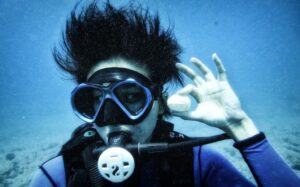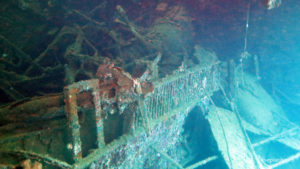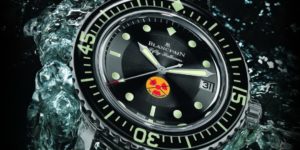Many modern era scuba divers show interest in the pioneer divers and their suits and hard hats. Understanding how these helmets work is useful knowledge.
The hard hat diving helmet of the old-style diving suits worn by the original deep-sea divers were the first scuba regulators that allowed a human to breathe underwater.
They were crude in their design, worked well enough to be functional; but in the pioneering underwater world with increased pressures and treacherous conditions, the diving helmet was also a dangerous piece of equipment.
The old diving helmets were made of copper and attached to the diving suit via a heavy plate sitting on the chest.
Air was pumped into the suit and helmet via a pipe from the surface.
The airline from the surface limits the depth the suited diver can go. The suits had heavy lead shoes that worked against the suit’s buoyancy to keep the diver on the sea bed.
The helmet had three or four glass windows to allow the diver to see out. The technical term for these is “lights” and they may have a metal mesh or grate over the glass to prevent breakage.
How Does Air Enter an Old Style Diving Helmet?
The airline from the pump on the support boat comes down to the front of the diver and then under his arm to the back of the helmet. Having the line in front of the diver means he can hold onto it and know where it is at all times.
Passing under the diver’s arm also prevents the airline from getting snagged on things underwater. Or breaking off at the connection to the helmet if the line gets a sudden jerk due to waves acting on the support boat.
The air hose connects to a valve, downward-facing, at the rear of the helmet. This valve is one-way so it allows air into the helmet and suit, but not out. This is set up so that if the air flow suddenly stops, the air trapped in the helmet and suit may be enough for the diver to ascend to the surface.
The air flows into the helmet via a series of ducts that set up a swirling movement of air within the helmet. This keeps the stale air away from the diver’s face.
How Does Air Get Out of an Old Style Diving Helmet?
The air exits the diving helmet via an outlet valve. Depending on the type of suit and helmet, the outlet valve may be positioned on the helmet, usually on the right-hand side. Some of the old diving suits have the outlet valve on the chest plate.
Air is pumped into the suit, the diver breathes as required, and the air is exhausted out the outlet vale. This outlet valve is adjustable so the diver can regulate the airflow, and therefore the air quality, in the helmet.
The adjustment of the outlet valve is a balance between the amount the surface pump can deliver, the quality of air in the suit and the amount of air needed in the suit to control the diver’s buoyancy.
The Spitcock
Another unique feature of the old-style diving helmets is the spitcock. This is a basic valve usually positioned to the right of the main “light”, and around the level of the diver’s chin.
The main purpose of this valve was to act as a quick dump valve. If the air was building up in the suit and the diver became too buoyant, the diver could open the spitcock and bleed off some excess air.
Another use of the spitcock is for the diver to clean the faceplate of the window. Inside the helmet the air was hot and humid causing that common malady for all divers: fogging of the face mask.
The diver would open the spitcock a fraction and the outside water pressure would force a small stream of water into the diver’s mouth. The diver would then squirt the water onto the faceplate of the “light” washing away the fogging.
Knowing how an old style diving suit and helmet works is a useful topic of conversation for the modern scuba diver. Something to discuss on a scuba dive holiday, or when chatting about the underwater world in general.












